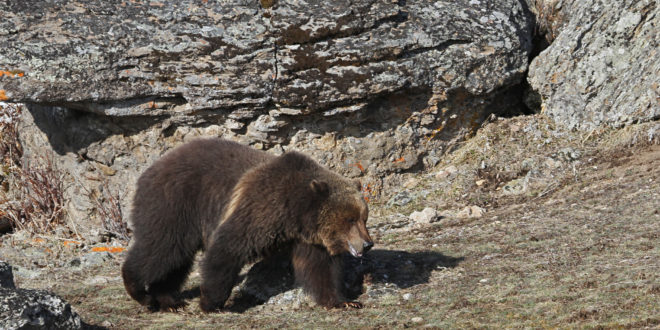Seventy-three scientists have penned a letter to Wyoming Governor Matt Mead calling on him to halt a proposed hunt on Yellowstone area grizzly bears.
The letter was sent April 25 but not reported until this week.
The news comes ahead of a May 23 meeting by the Wyoming Game and Fish Department to finalize hunting regulations.
According to Nature, in addition to delaying the meeting, the scientists called for “a panel of independent experts” to review data on the area’s grizzly populations. The letter states said experts are concerned the current grizzly counts overestimate the number of bears in the Greater Yellowstone Ecosystem. Hunting, the letter warns, could lead to a precipitous decline in the Yellowstone area grizzly bear population.
The U.S. Fish and Wildlife Service stripped protections from Yellowstone area grizzly bears in June 2017, following several years of debate. The USFWS previously attempted to delist the bears in 2007; protections were reinstated in 2009. The states of Montana, Wyoming, and Idaho assumed management of the species in August 2017. As part of the agreement, the states were each allotted grizzly quotas for any proposed hunt, which would apply to the “demographic monitoring area” that roughly covers the Greater Yellowstone Area.
Wyoming has proposed a hunting season on up to 24 grizzly bears—12 in the DMA and 12 outside the DMA. Idaho has proposed hunting one male grizzly. Montana has declined to host a hunting season this year, citing ongoing litigation against the USFWS.
Currently, six conservation and animal advocacy groups are suing the USFWS, alleging the agency erred in delisting Yellowstone area grizzly bears. A hearing in that case is scheduled in August 2018.
In December 2017, the USFWS announced it would revisit the decision, citing a ruling against the agency where a federal judge ruled the agency erred in its attempt to delist gray wolves living in the Great Lakes region.
Among the critics of delisting include David Mattson, a wildlife researcher who worked for the US. Geological Survey. Mattson argues bears cannot be considered recovered until they reestablish themselves and establish “connectivity” between other isolated populations. Mattson also cites evidence that female grizzlies reproduce less as they age, which goes against the prevailing assumption that they reproduce for life.
Frank van Manen, head of the Interagency Grizzly Bear Study Team, has pushed back against critics of delisting, saying that the current population estimate is “extremely conservative” and is the product of a range of methods like aerial surveying and individual tagging.
Critics of delisting have also cited changing food sources and incidental grizzly mortality as a reason to halt hunting, saying the population cannot sustain that barrage of factors. From Nature:
Mattson and the other researchers who wrote to the governor about the hunt listed several concerns in their letter. Some of the bear’s food, including cutthroat trout (Oncorhynchus clarkii) and whitebark pine (Pinus albicaulis), will probably become even scarcer in the future as a result of environmental changes, the researchers say. This will threaten the survival of some bears and push them to hunt livestock or look for food near houses, increasing their run-ins with people, says Mattson. This could lead to a rise in the number of animals killed as a result of these conflicts, which would further shrink the population.
Size matters
Even if the current population estimates are accurate, removing 24 animals through hunting could have detrimental effects, says Andrea Santarsiere, an attorney at the Center for Biological Diversity who is based in Victor, Idaho. In 2017, 56 bears died in the IGBST monitoring area as a result of natural causes or conflicts with people. “If the same amount dies this year, we could be looking at up to 80 bears removed from the population,” Santarsiere says. “That’s about 10% of the current population.”
Van Manen, along with state wildlife officials, have pushed back against this claim, saying any hunt would be well regulated, with hunters required to take courses on grizzly identification and wear tracking devices. In addition, all hunting would cease if two female grizzlies are killed across the entire Greater Yellowstone Ecosystem.
 Yellowstone Insider Your Complete Guide to America's First National Park
Yellowstone Insider Your Complete Guide to America's First National Park





